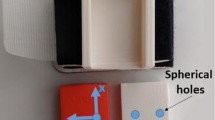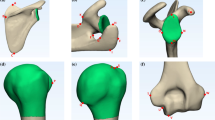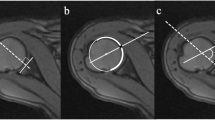Abstract
This study aimed to find the most appropriate marker location, or combination thereof, for the centre of the humeral head (Wang et al. in J Biomech 31: 899–908, 1998) location representation during humeral motion. Ten male participants underwent three MRI scans in three different humeral postures. Seven technical coordinate systems (TCS) were defined from various combinations of an acromion, distal upper arm and proximal upper arm clusters of markers in a custom Matlab program. The CHH location was transformed between postures and then compared with the original MRI CHH location. The results demonstrated that following the performance of two near 180° humeral elevations, a combined acromion TCS and proximal upper arm TCS produced an average error of 23 ± 9 mm, and 18 ± 4 mm, which was significantly smaller (p < 0.01) than any other TCS. A combination of acromion and proximal upper arm TCSs should therefore be used to reference the CHH location when analysing movements incorporating large ranges of shoulder motion.





Similar content being viewed by others
References
Alexander EJ, Andriacchi TP (2001) Correcting for deformation in skin-based marker systems. J Biomech 34:355–361. doi:10.1016/S0021-9290(00)00192-5
Andriacchi TP, Alexander EJ, Toney MK, Dyrby C, Sum J (1998) A point cluster method for in vivo motion analysis: applied to a study of knee kinematics. J Biomech Eng 120:743–749. doi:10.1115/1.2834888
Cappello A, Stagni R, Fantozzi S, Leardini A (2005) Soft tissue artifact compensation in knee kinematics by double anatomical landmark calibration: performance of a novel method during selected motor tasks. IEEE Trans Biomed Eng 52:992–998. doi:10.1109/TBME.2005.846728
Cappozzo A, Catani F, Croce UD, Leardini A (1995) Position and orientation in space of bones during movement: anatomical frame definition and determination. Clin Biomech (Bristol, Avon) 10:171–178. doi:10.1016/0268-0033(95)91394-T
Cappozzo A, Catani F, Leardini A, Benedetti MG, Croce UD (1996) Position and orientation in space of bones during movement: experimental artefacts. Clin Biomech (Bristol, Avon) 11:90–100. doi:10.1016/0268-0033(95)00046-1
Cappozzo A, Cappello A, Della Croce U, Pensalfini F (1997) Surface-marker cluster design criteria for 3-D bone movement reconstruction. IEEE Trans Biomed Eng 44:1165–1174. doi:10.1109/10.649988
Cerveri P, Pedotti A, Ferrigno G (2005) Kinematical models to reduce the effect of skin artifacts on marker-based human motion estimation. J Biomech 38:2228–2236. doi:10.1016/j.jbiomech.2004.09.032
Cutti AG, Cappello A, Davalli A (2006) In vivo validation of a new technique that compensates for soft tissue artefact in the upper-arm: preliminary results. Clin Biomech (Bristol, Avon) 21(Suppl 1):S13–S19. doi:10.1016/j.clinbiomech.2005.09.018
Della Croce U, Cappozzo A, Kerrigan C, Lucchetti L (1997) Bone position and orientation errors: pelvis and lower limb anatomical landmark identification reliability. Gait Posture 5:156–157. doi:10.1016/S0966-6362(97)83382-6
Graichen H, Stammberger T, Bonel H, Karl-Hans E, Reiser M, Eckstein F (2000) Glenohumeral translation during active and passive elevation of the shoulder—a 3D open-MRI study. J Biomech 33:609–613. doi:10.1016/S0021-9290(99)00209-2
Karduna AR, McClure PW, Michener LA, Sennett B (2001) Dynamic measurements of three-dimensional scapular kinematics: a validation study. J Biomech Eng 123:184–190. doi:10.1115/1.1351892
Leardini A, Chiari L, Della Croce U, Cappozzo A (2005) Human movement analysis using stereophotogrammetry. Part 3. Soft tissue artifact assessment and compensation. Gait Posture 21:212–225. doi:10.1016/j.gaitpost.2004.05.002
Meskers CG, van der Helm FC, Rozendaal LA, Rozing PM (1998) In vivo estimation of the glenohumeral joint rotation center from scapular bony landmarks by linear regression. J Biomech 31:93–96. doi:10.1016/S0021-9290(97)00101-2
Rab G, Petuskey K, Bagley A (2002) A method for determination of upper extremity kinematics. Gait Posture 15:113–119. doi:10.1016/S0966-6362(01)00155-2
Riemer R, Hsiao-Wecksler ET, Zhang X (2007) Uncertainties in inverse dynamics solutions: a comprehensive analysis and an application to gait. Gait Posture 27:578–588
Schmidt R, Disselhorst-Klug C, Silny J, Rau G (1999) A marker-based measurement procedure for unconstrained wrist and elbow motions. J Biomech 32:615–621. doi:10.1016/S0021-9290(99)00036-6
Stagni R, Leardini A, Cappozzo A, Grazia Benedetti M, Cappello A (2000) Effects of hip joint centre mislocation on gait analysis results. J Biomech 33:1479–1487. doi:10.1016/S0021-9290(00)00093-2
Stagni R, Fantozzi S, Cappello A, Leardini A (2005) Quantification of soft tissue artefact in motion analysis by combining 3D fluoroscopy and stereophotogrammetry: a study on two subjects. Clin Biomech (Bristol, Avon) 20:320–329. doi:10.1016/j.clinbiomech.2004.11.012
Stagni R, Fantozzi S, Cappello A (2006) Propagation of anatomical landmark misplacement to knee kinematics: performance of single and double calibration. Gait Posture 24:137–141. doi:10.1016/j.gaitpost.2006.08.001
Stokdijk M, Nagels J, Rozing PM (2000) The glenohumeral joint rotation centre in vivo. J Biomech 33:1629–1636. doi:10.1016/S0021-9290(00)00121-4
Veeger HE, Yu B, An KN, Rozendal RH (1997) Parameters for modeling the upper extremity. J Biomech 30:647–652. doi:10.1016/S0021-9290(97)00011-0
Wang X, Maurin M, Mazet F, De Castro Maia N, Voinot K, Verriest JP, Fayet M (1998) Three-dimensional modelling of the motion range of axial rotation of the upper arm. J Biomech 31:899–908. doi:10.1016/S0021-9290(98)00098-0
Wu G, van der Helm FC, Veeger HE, Makhsous M, Van Roy P, Anglin C, Nagels J, Karduna AR, McQuade K, Wang X, Werner FW, Buchholz B (2005) ISB recommendation on definitions of joint coordinate systems of various joints for the reporting of human joint motion—Part II: shoulder, elbow, wrist and hand. J Biomech 38:981–992. doi:10.1016/j.jbiomech.2004.05.042
Acknowledgments
This paper was supported by a University of Western Australia small grant.
Author information
Authors and Affiliations
Corresponding author
Rights and permissions
About this article
Cite this article
Campbell, A.C., Alderson, J.A., Lloyd, D.G. et al. Effects of different technical coordinate system definitions on the three dimensional representation of the glenohumeral joint centre. Med Biol Eng Comput 47, 543–550 (2009). https://doi.org/10.1007/s11517-009-0467-7
Received:
Accepted:
Published:
Issue Date:
DOI: https://doi.org/10.1007/s11517-009-0467-7




